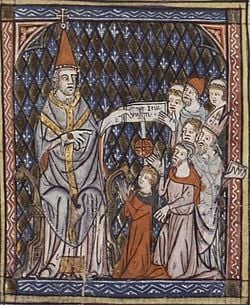Difference between revisions of "Pope Callixtus I" - New World Encyclopedia
(New page: {{Infobox Pope| English name=Callixtus I| image=250px| birth_name=Callixtus or Callistus| term_start=217| term_end=222| predecessor=Zephyrinus| ...) |
m |
||
| Line 45: | Line 45: | ||
[[Category:religion]] | [[Category:religion]] | ||
| + | [[Category:biography]] | ||
{{Credit|192584112}} | {{Credit|192584112}} | ||
Revision as of 02:52, 4 April 2008
| Callixtus I | |
|---|---|

| |
| Birth name | Callixtus or Callistus |
| Papacy began | 217 |
| Papacy ended | 222 |
| Predecessor | Zephyrinus |
| Successor | Urban I |
| Born | ??? ??? |
| Died | 222 ??? |
| Other popes named Callixtus | |
Pope Saint Callixtus I or Callistus I, was pope from about 217 to about 222, during the reigns of the Roman Emperors Heliogabalus and Alexander Severus. He was martyred for his Christian faith and is a canonized saint of the Roman Catholic Church.
His contemporary and enemy, the author of Philosophumena (probably Hippolytus of Rome) relates that when Callixtus, as a young slave was put in charge of a bank by his master, Carpophorus, he lost the money deposited by other Christians. Callixtus then fled from Rome, but was caught near Portus. According to the tale, Callixtus jumped overboard to avoid capture, but was rescued and taken back to his master. He was released at the request of the creditors, who hoped he might be able to recover some of the money, but was rearrested for fighting in a synagogue when he tried to borrow or collect debts from some Jews. Denounced as a Christian, Callixtus was sentenced to work in the mines of Sardinia. Finally, he was released with other Christians at the request of Hyacinthus, a eunuch presbyter, who represented Marcia, a mistress of Emperor Commodus. His health was so weakened that his fellow Christians sent him to Antium to recuperate and he was given a pension by Pope Victor I.
Callixtus was the deacon to whom Pope Zephyrinus (199-217) entrusted the burial chambers along the Appian Way, which had been completely lost and forgotten, until in 1849 they were rediscovered by the archaeologist Giovanni Battista de Rossi. In the third century, nine Bishops of Rome were interred in the chamber of the Catacombs of San Callisto now called the Capella dei Papi.
When Callixtus followed Zephyrinus as Bishop of Rome, he established the practice of the absolution of all repented sins, for which Tertullian took him to task (De Pudicitia xxi). The United States Conference of Catholic Bishops introduction to saints notes that St. Callistus is "most renowned for the reconciliation of sinners, who following a period of penance, were re-admitted to communion with the Church." [1] Hippolytus and Tertullian were especially upset by the pope's admitting to communion those who had repented for murder, adultery, and fornication, as well as by his alleged belief in Sabellianism, which he attempted to distance himself from.
In an apocryphal anecdote in the collection of imperial biographies called the Historia Augustae, the spot on which he had built an oratory was claimed by tavern keepers, but the emperor decided that the worship of any god was better than a tavern. The story is the basis for dating the original structure of the present Basilica di Santa Maria in Trastevere.
The Basilica di Santa Maria in Trastevere was a titulus of which Callixtus was the patron. The 4th-century basilica of Ss Callixti et Iuliani (Callixtus and Pope Julius I) was rebuilt in the 12th century by Pope Innocent II and rededicated to the Blessed Virgin Mary. The 8th-century Chiesa di San Callisto is close by, with its beginnings apparently as a shrine on the site of his martyrdom, which is attested in the 4th-century Deposition Martyri and so is likely to be historical. It is possible that Callixtus was martyred around 222, perhaps during a popular uprising, but the legend that he was thrown down a well has no historical foundation, though the church does contain an ancient well (Nyborg).
Callixtus was honored as a martyr in Todi, Italy, on August 14. He was buried in the cemetery of Calepodius on the Aurelian Way and his anniversary is given by the 4th-century Depositio Martirum (Callisti in viâ Aureliâ miliario III) and by the subsequent martyrologies on 14 October. According to the Catholic Encyclopedia, his relics were translated in the 9th century to the predecessor of Santa Maria in Trastevere.
The Roman Catholic Church keeps the feast day of Pope Saint Callixtus I on October 14.
The Acta of Callixtus are imaginary (CE "Pope St Callistus I").
ReferencesISBN links support NWE through referral fees
- Catholic Encyclopedia 1908: "Pope St. Callistus"
- Encyclopaedia Britannica: Saint Calixtus I
- Chris Nyborg, "San Callisto": the church
- Chris Nyborg, "Churches of Rome: Catacombe di San Callisto"
| Roman Catholic Popes | ||
|---|---|---|
| Preceded by: Zephyrinus |
Bishop of Rome Pope 217–222 |
Succeeded by: Urban I |
| ||||||||||||||||
Credits
New World Encyclopedia writers and editors rewrote and completed the Wikipedia article in accordance with New World Encyclopedia standards. This article abides by terms of the Creative Commons CC-by-sa 3.0 License (CC-by-sa), which may be used and disseminated with proper attribution. Credit is due under the terms of this license that can reference both the New World Encyclopedia contributors and the selfless volunteer contributors of the Wikimedia Foundation. To cite this article click here for a list of acceptable citing formats.The history of earlier contributions by wikipedians is accessible to researchers here:
The history of this article since it was imported to New World Encyclopedia:
Note: Some restrictions may apply to use of individual images which are separately licensed.